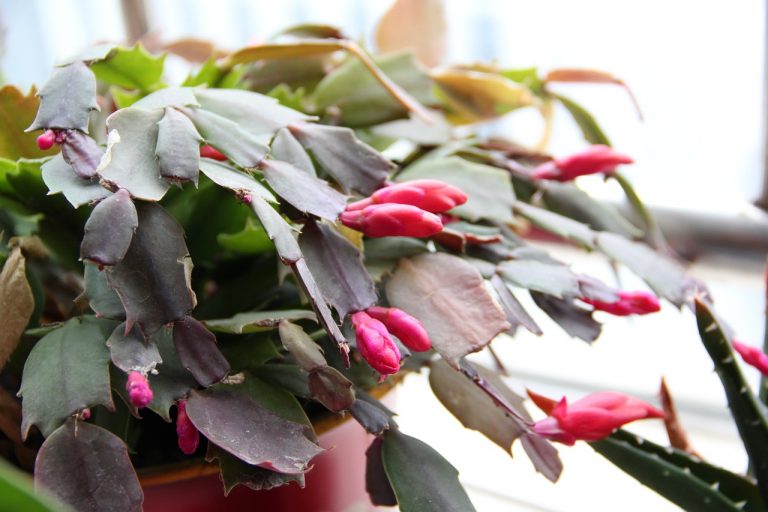You know the holidays are just around the corner when Christmas cactus start to bloom (hence their name). When they bloom, they produce stunning, colorful tubular flowers in lilac, white, red-fuchsia or pink flowers, making them wonderful additions to any home.
Christmas cacti add color to your holiday decorations. If you want an abundance of these colorful flowers in your home, here’s an idea: Christmas cactus propagation. You’ll hit two goals with one green project: fill the house with lovely holiday glowers AND get the family involved in a fun gardening project.
Before you start propagating your Christmas cactus, here’s what you need to know about this blooming houseplant.
Meet the Christmas Cactus
The Christmas cactus (scientific name: Schlumbergera) is a low-maintenance plant that originated from the mountains of Brazil. As mentioned above, these houseplants promise gorgeous blooms around the time of their namesake holiday.

Unlike most species of cacti, Christmas cacti are epiphytic cacti, which mean they don’t grow in the ground. Instead, they thrive in the crevices of trees and rocks. They collect the debris that grows in these areas.
Christmas cacti are easy-to-care-for, which makes them a great gardening project for beginners (like you and/or your kids). Also, Christmas cactus propagation is easier than you think. All you need are the right tools, proper techniques and plenty of patience!
How to Propagate a Christmas Cactus?
There are three different ways to propagate your Christmas cacti: flat in soil, upright in soil and in water. Before you propagate them, you need to get a healthy cutting first.
Christmas cacti are made up of different pads (or sections) that are linked together. At the bottom of the pad is an area where you can encourage root growth. This part, however, can be tricky since you must separate the pads without tearing its bottom part. If you damage the bottom, the cutting will most likely fail.
The easiest way to ensure a healthy cutting is to gently twist the pad away from the bottom. A gentle twist of the top pad makes your cactus pad easily come apart.

Once you’ve got the cutting, you can proceed to one of the three ways to propagate your cactus:
- Christmas cactus propagation in water. This is one of the fastest ways to propagate your cuttings. Christmas cactus cuttings in water grow roots weeks before the cactus propagated in the soil. When you root your cuttings in water, however, you’ll need to still transfer the cuttings to soil.A good callus spares you from water Christmas cactus propagation problems. To do this, get a good cutting and leave it out to dry (keep it out of direct sunlight). Next, once the leaf is thinner, put it in the water to avoid wrinkles. You’ve left your cutting out for long if you see wrinkle lines.A cactus cutting is dried enough if you see a good callus, which you can put in the water without worrying about rotting. If your cactus cutting rots, leave the cuttings out for drying longer next time.
One of the common questions concerning water propagation is “How long can you root a piece of Christmas cactus in the water?” You can leave it there for several weeks or until the roots measure an inch or two in length. Also, don’t forget to change the water every few days to prevent bacterial rot.
Once your cuttings are ready to pot, use well-draining soil (e.g. regular soil mixed with perlite or succulent and cactus soil mix). This guarantees a successful transfer from water to the soil.
- Propagating Christmas cactus upright in the soil. This method is ideal if you have large cactus cuttings (around four pads each) and if tears are absent from the bottom of your cuttings’ pads.In this process, you take your cutting and lay it in a dry area for a day or two. Similar to the first method, keep them out of direct sunlight. This resting period helps your Christmas cactus transition from growing shoots to developing roots.After a day or two, plant your cuttings into fresh soil (succulent and cactus soil mix is your best option). Place the cactus’ end far down to ensure the soil totally covers the bottom pad. Afterward, water it lightly and let it dry enough before you water again. Give it two to three weeks for root formation.
- Propagating Christmas cactus flat in soil. If you want to do soil propagation but your cuttings are too small, this method is your best option. It’s also the best for damaged bottom pads.Similar to the previous method, dry out the cutting for a day or two. Next, instead of planting it directly in the soil, place the cuttings horizontally on top of it. You’ll need light soil for the job. Also, make sure that there is good contact between the point where the two cactus pads meet and the soil. This is where the new roots will grow from (in about two to three weeks).NOTE: This type of rooting increases the chances of the cactus pad becoming too moist, which could lead to rotting. Avoid this by getting the soil wet first before you water the Christmas cactus. Always keep the cutting dry.
How to Care for Your Christmas Cactus (Post-Rooting)
Once you’ve transplanted your cacti to their proper pots, water them regularly, especially during the summer and spring season. Saturating causes the root to rot so you need to water it thoroughly without soaking or saturating the soil.

To encourage the cactus to bloom more, keep it cool following their blooming period. Keep the soil just moist enough and withhold fertilizer. When the cactus begins to bloom, house them in an area with a temperature between 55 and 65 degrees. Once the buds start to appear, place your plants in warmer areas and start regular culture.
Other Things to Note About Christmas Cactus Care
Once your Christmas cactus cuttings grow their roots, start caring for them in the same way you’d care for a mature cactus. Similar to other succulents, the Christmas cactus thrives in drought but doesn’t respond well to under-watering or overwatering. Be mindful of how often you water your cacti.
Other things to note are:
- “What to do if a piece of the cactus breaks off?” If a piece of the Christmas cactus breaks off, you can still plant the broken piece. However, you’ll need to give the broken piece time to harden before you plant it in its pot.
- “How can you tell if a Christmas cactus is overwatered?” One of the most obvious symptoms is the limp leaves. When the leaves start to drop off, the branches and stems will eventually soften and become mushy. Severe overwatering causes the plants to emit a foul odor before it completely rots.
- “Can an overwatered cactus be saved?” If you have been overwatering your Christmas cactus, take the plant out of the pot and re-pot it with a dry potting mix. Once you’ve re-potted the cactus, lay it out to dry for a few days before you water the plant lightly.
- “How do you root a broken piece of cactus?” Propagating is the easiest way to do so. Practice all the steps mentioned above.
- “How can you force your Christmas cactus to bloom?” To encourage your cactus to bloom for the holidays, put it in a dark closet for 14 hours a night. Next, bring it back into a bright location during the day. Once the buds form, you don’t have to put the cactus back in the closet. Do this for six to eight weeks before your target date.
Christmas cacti are one of the best ways to add festive colors to your home, as well as encourage the family to try their hand at mini gardening projects. The right tools, techniques and plenty of patience will reward you with pretty festive buds — just in time for the holiday season!











